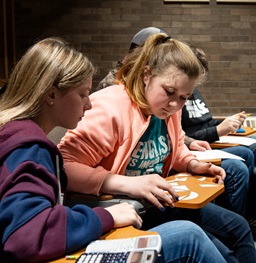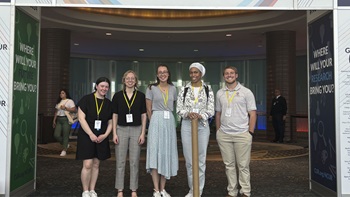Fall 2025 Seminars
September 3, 4pm-5pm, UP 222
Warren McGovern, Florida Atlantic University
Title: Algebraic Frames
Abstract: A frame is a complete (bounded) distributive lattice (L, v, A), 0, 1) that satisfies the strengthened distributive law. The collection of open subsets of a topological space is a special kind of frame, called a spatial frame. Frames appear in the context of algebraic objects. For example, the collection of radical ideal of a commutative ring with identity is a frame, as well as the collection of convex subgroups of a lattice-ordered group. These two examples are examples of algebraic frames. By Zorn’s Lemma, each algebraic frame is spatial. Most of the research on algebraic frames has been in the subclass of M-frames (algebraic frames with the FIP). We shall discuss ways of constructing algebraic frames that do not satisfy FIP and interesting results that arise.
September 24, virtual (on Zoom)
Jamie Bowater, University of Exeter, UK
Title: Analogy-based inference: a universal school of statistical inference
Abstract: Standard statistical theory has arguably proved to be unsuitable as a basis for constructing a satisfactory completely general framework for performing statistical inference. For example, in using empiricist theory, which attempts to justify methods of inference through their empirical performance when used repeatedly, inferences made about a population quantity are only relevant to a reference class of cases, which will inevitably include unobserved cases, rather than being directly relevant to the case at hand. Also, in using axiomatic theory, which is based on the idea of deducing statistical inferences about a population of interest from a given set of universally acceptable axioms, the difficulty is encountered of finding such axioms that are weak enough to be widely acceptable, but strong enough to lead to methods of inference that can be regarded as being efficient. These observations justify the need to take a serious look at an alternative avenue through which statistical inference may be performed, and in particular, the one that is offered by analogy making. In doing this, the use of analogy making will be explored in this talk not just as a supplementary means of understanding how statistical methods work, but as the fundamental basis of an up until now overlooked but nevertheless major school of statistical inference.
October 15, 4pm-5pm, UP 222
George Nasr, Augustana University, Sioux Falls
Title: DP for 2-Partition Maximal Symmetric Polytopes
Abstract: The Integer Decomposition Property (IDP) for a polytope P essentially asks if the points in any scaled version of a polytope can be written as a sum of points in P itself. Despite a seemingly trite definition, asking if a polytope has IDP is among the many popular problems in discrete mathematics that has a breadth of applications, from solving other questions in discrete mathematics like understanding Ehrhart polynomials, to understanding properties of abstractly defined algebraic structures associated to polytopes, to optimization for integer programing problems whose constraints define a polytope. We provide a framework for which one can approach showing the integer decomposition property for symmetric polytopes. We utilize this framework to prove a special case which we refer to as 2-partition maximal polytopes in the case where it lies in a hyperplane of R^3. Our method involves proving a special collection of polynomials have saturated Newton polytope.
October 29, 4pm-5pm, UP 222
Mariam Khachatryan, Augustana University, Sioux Falls
Title: Persistence and positive steady states of a two-stage structured population model with mixed dispersals
Abstract: In this talk, we will discuss our studies on a two-stage structured population model for which the juveniles diffuse purely by random walk while the adults exhibit long range dispersal. Questions on the persistence or extinction of the species are examined. It is shown that the population eventually dies out if the principal spectrum point $\lambda_p$ of the linearized system at the trivial solution is nonpositive. However, the species persists if $\lambda_p >0$. Moreover, at least one positive steady state exists when $\lambda_p >O$. The uniqueness and global stability of the positive steady state solution is obtained under some special cases. We also establish a sup/inf characterization of $\lambda_p$.
November 5, 4pm-5pm, Room TBA
Enrique Alvarado, Iowa State University
Title: Parameter Selection for Mapper
Abstract: Mapper is a popular Topological Data Analysis tool that is used to investigate the shape and features of point cloud data. Other than the data, the Mapper algorithm needs a few more parameters. It needs a topological space Y, an open cover of Y, and a function (called a filter function) that maps your data into Y. In the context of the application, sometimes there is a natural choice for the filter function, and hence Y. However, it is rarely the case that there is a natural choice for the open cover of Y. In this talk, we will investigate the ways in which one can optimally choose the open cover for Y, and we will investigate some recent work of mine related to inverse Mapper/Reeb space problems.


























